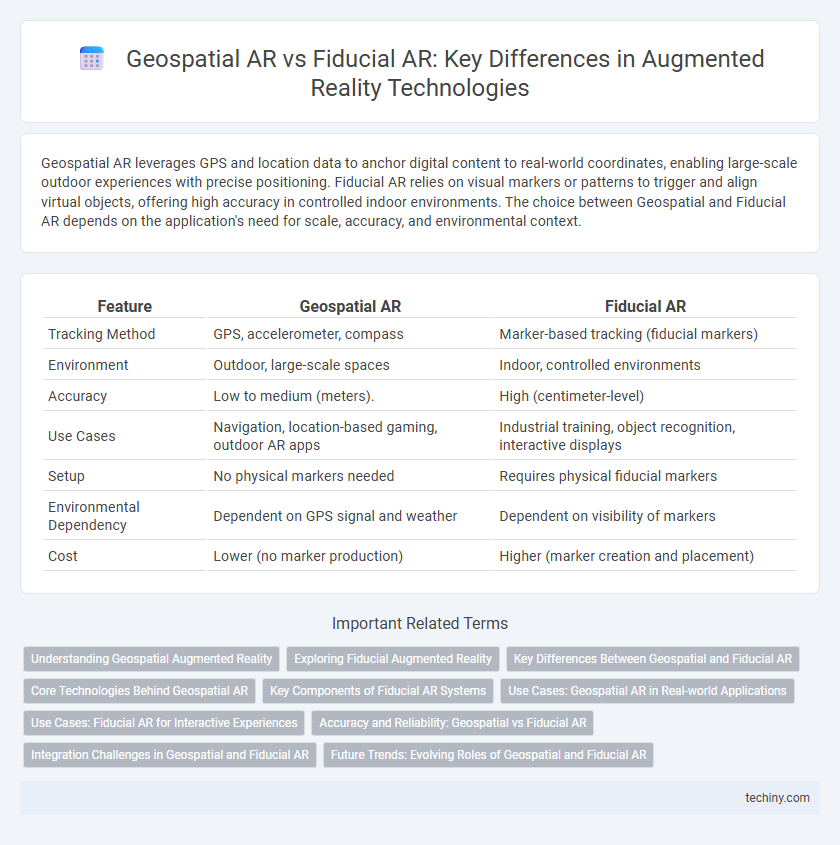Geospatial AR leverages GPS and location data to anchor digital content to real-world coordinates, enabling large-scale outdoor experiences with precise positioning. Fiducial AR relies on visual markers or patterns to trigger and align virtual objects, offering high accuracy in controlled indoor environments. The choice between Geospatial and Fiducial AR depends on the application's need for scale, accuracy, and environmental context.
Table of Comparison
| Feature | Geospatial AR | Fiducial AR |
|---|---|---|
| Tracking Method | GPS, accelerometer, compass | Marker-based tracking (fiducial markers) |
| Environment | Outdoor, large-scale spaces | Indoor, controlled environments |
| Accuracy | Low to medium (meters). | High (centimeter-level) |
| Use Cases | Navigation, location-based gaming, outdoor AR apps | Industrial training, object recognition, interactive displays |
| Setup | No physical markers needed | Requires physical fiducial markers |
| Environmental Dependency | Dependent on GPS signal and weather | Dependent on visibility of markers |
| Cost | Lower (no marker production) | Higher (marker creation and placement) |
Understanding Geospatial Augmented Reality
Geospatial Augmented Reality (AR) integrates digital content with the real world by leveraging GPS, accelerometers, and compasses to accurately position virtual objects based on geographic coordinates, enhancing location-based experiences. Unlike Fiducial AR, which relies on predefined markers or fiducial patterns for object recognition and overlay, Geospatial AR provides a more flexible, markerless interaction that enables broad outdoor applications such as navigation, urban planning, and tourism. Understanding Geospatial AR involves grasping its dependence on real-time spatial data and global positioning systems to create seamless, context-aware augmented environments.
Exploring Fiducial Augmented Reality
Fiducial Augmented Reality relies on predefined markers or patterns to accurately overlay digital content onto the physical environment, enabling precise tracking and interaction. This approach enhances user experiences in applications like industrial maintenance and education by providing stable and reliable augmentation anchored to specific visual cues. Compared to Geospatial AR, which depends on GPS and environmental data, Fiducial AR offers higher positional accuracy in controlled settings, facilitating detailed and context-specific information delivery.
Key Differences Between Geospatial and Fiducial AR
Geospatial AR utilizes GPS, accelerometers, and compass data to anchor virtual content in the real world based on geographic coordinates, enabling large-scale outdoor experiences. Fiducial AR relies on visual markers such as QR codes or printed images to trigger and position augmented content, providing precise tracking within localized environments. The primary difference lies in Geospatial AR's location-based anchoring for broad spatial interaction versus Fiducial AR's marker-based system designed for controlled, close-range applications.
Core Technologies Behind Geospatial AR
Geospatial AR relies on advanced GPS, computer vision, and simultaneous localization and mapping (SLAM) technologies to accurately position virtual objects in real-world geographic locations. This core technology stack enables precise tracking and environmental understanding without the need for physical markers, unlike Fiducial AR which depends on image-based markers for object recognition. High-resolution spatial mapping combined with inertial sensors enhances geospatial AR's capability to deliver immersive and scalable augmented experiences in outdoor and large-scale environments.
Key Components of Fiducial AR Systems
Fiducial AR systems rely on key components such as fiducial markers, which act as visual references for precise tracking and alignment of virtual objects in the physical environment. High-resolution cameras capture these markers, while computer vision algorithms process the marker patterns to determine the camera's pose, enabling accurate augmentation. This setup ensures stable and reliable overlay of digital content, particularly in controlled or indoor settings where environmental variables are limited.
Use Cases: Geospatial AR in Real-world Applications
Geospatial AR leverages GPS, accelerometers, and 3D mapping to overlay digital information accurately onto real-world locations, making it ideal for navigation, urban planning, and outdoor gaming. Fiducial AR uses markers or predefined images to trigger digital content, often suited for indoor environments, product visualization, and interactive installations. Geospatial AR's real-world applications enable enhanced situational awareness for tourists, emergency responders, and field workers by providing context-aware data anchored to physical geography.
Use Cases: Fiducial AR for Interactive Experiences
Fiducial AR enhances interactive experiences by using recognizable markers or patterns to trigger digital content, ideal for marketing campaigns, educational tools, and museum exhibits. This approach allows precise tracking and stable overlays, making it suitable for product demonstrations and gamified environments where user engagement is critical. Businesses leverage Fiducial AR to create immersive, context-specific interactions that drive customer participation and retention.
Accuracy and Reliability: Geospatial vs Fiducial AR
Geospatial AR leverages GPS, accelerometers, and digital maps to anchor virtual content to real-world locations, offering scalable outdoor experiences but with accuracy limitations of a few meters due to signal variability. Fiducial AR relies on precise markers or patterns detected by the camera, enabling centimeter-level accuracy and consistent tracking in controlled indoor environments. While Geospatial AR provides broad coverage, Fiducial AR delivers superior reliability and precision for applications requiring exact alignment and stable visualization.
Integration Challenges in Geospatial and Fiducial AR
Geospatial AR faces integration challenges primarily due to the reliance on GPS accuracy and real-time mapping data, which can be inconsistent in dense urban environments or indoor settings. Fiducial AR, while benefiting from precise marker detection, struggles with marker occlusion and varying lighting conditions that hinder seamless overlay integration. Both technologies require robust algorithms to synchronize virtual elements with the physical world, demanding advanced sensor fusion and real-time data processing for effective augmentation.
Future Trends: Evolving Roles of Geospatial and Fiducial AR
Future trends in augmented reality highlight the evolving roles of geospatial AR and fiducial AR, with geospatial AR increasingly leveraging GPS, LiDAR, and advanced mapping technologies to provide expansive, real-world contextual overlays for urban planning and autonomous navigation. Fiducial AR continues to advance through enhanced marker recognition and machine learning algorithms, enabling precise object tracking and interactive experiences in industrial automation and retail environments. The convergence of geospatial data integration and fiducial marker precision is expected to drive hybrid AR systems that offer seamless user experiences across diverse applications.
Geospatial AR vs Fiducial AR Infographic

 techiny.com
techiny.com